Lead Selenide Polycrystalline Coatings Sensitized Using Diffusion and Ion Beam Methods for Uncooled Mid-Infrared Photodetection
Abstract
:1. Introduction
How Can the Optoelectronic Sensitization Enable Photosensitivity Enhancement Without Cooling?
2. Optoelectronic Sensitization Models toward Physical Mechanisms
2.1. The Minority Carrier Trap Model
2.2. The Barrier Model
2.3. The Generalized Model
2.4. The Charge Separation Junction Model
3. Fabrications and Properties of the PbSe Polycrystalline Coatings
3.1. The Functional Effects Induced by Oxygen Treatment
3.2. The Iodination Impact on the Photosensitivity
3.3. Stoichiometric Optimization via Iodine Concentration Regulation
3.4. The Properties of Surface Functional Layer
3.4.1. Phase Analysis
3.4.2. Structural Analysis
3.5. Growth with the Nanostructured Antireflective Coatings
3.6. Preparation via Ion Beam Implantation
4. Interesting Areas, Challenges, and Perspectives
4.1. Electrical Properties
4.2. Growth Mechanism-Related Calculations
4.3. New Preparation Technologies
4.4. Compounding with Other Materials and Structures
5. Summary
Author Contributions
Funding
Conflicts of Interest
References
- Tabachnyk, M.; Ehrler, B.; Gelinas, S.; Bohm, M.L.; Walker, B.J.; Musselman, K.P.; Greenham, N.C.; Friend, R.H.; Rao, A. Resonant energy transfer of triplet excitons from pentacene to PbSe nanocrystals. Nat. Mater. 2014, 13, 1033–1038. [Google Scholar] [CrossRef] [PubMed]
- Sykora, M.; Koposov, A.Y.; McGuire, J.A.; Schulze, R.K.; Tretiak, O.; Pietryga, J.M.; Klimov, V.I. Effect of Air Exposure on Surface Properties, Electronic Structure, and Carrier Relaxation in PbSe Nanocrystals. ACS Nano 2010, 4, 2021–2034. [Google Scholar] [CrossRef] [PubMed]
- Tisdale, W.A.; Williams, K.J.; Timp, B.A.; Norris, D.J.; Aydil, E.S.; Zhu, X.Y. Hot-Electron Transfer from Semiconductor Nanocrystals. Science 2010, 328, 1543–1547. [Google Scholar] [CrossRef] [PubMed]
- Sliem, M.A.; Chemseddine, A.; Bloeck, U.; Fischer, R.A. PbSe nanocrystal shape development: Oriented attachment at mild conditions and microwave assisted growth of nanocubes. CrystEngComm 2011, 13, 483–488. [Google Scholar] [CrossRef]
- Schaller, R.D.; Klimov, V.I. High efficiency carrier multiplication in PbSe nanocrystals: Implications for solar energy conversion. Phys. Rev. Lett. 2004, 92, 186601. [Google Scholar] [CrossRef] [PubMed]
- Liu, Y.; Gibbs, M.; Puthussery, J.; Gaik, S.; Ihly, R.; Hillhouse, H.W.; Law, M. Dependence of Carrier Mobility on Nanocrystal Size and Ligand Length in PbSe Nanocrystal Solids. Nano Lett. 2010, 10, 1960–1969. [Google Scholar] [CrossRef]
- Casavola, M.; van Huis, M.A.; Bals, S.; Lambert, K.; Hens, Z.; Vanmaekelbergh, D. Anisotropic Cation Exchange in PbSe/CdSe Core/Shell Nanocrystals of Different Geometry. Chem. Mater. 2012, 24, 294–302. [Google Scholar] [CrossRef]
- Skelton, J.M.; Parker, S.C.; Togo, A.; Tanaka, I.; Walsh, A. Thermal physics of the lead chalcogenides PbS, PbSe, and PbTe from first principles. Phys. Rev. B 2014, 89, 205203. [Google Scholar] [CrossRef] [Green Version]
- Akselrod, G.M.; Weidman, M.C.; Li, Y.; Argyropoulos, C.; Tisdale, W.A.; Mikkelsen, M.H. Efficient Nanosecond Photoluminescence from Infrared PbS Quantum Dots Coupled to Plasmonic Nanoantennas. ACS Photonics 2016, 3, 1741–1746. [Google Scholar] [CrossRef]
- Sadeghi, H.; Zolanvar, A.; Ranjgar, A. Effective dielectric constant of metal chalcogenides Ag-PbSe nanocomposite. Armen. J. Phys. 2014, 7, 75–86. [Google Scholar]
- Segets, D.; Lucas, J.M.; Taylor, R.N.K.; Scheele, M.; Zheng, H.M.; Alivisatos, A.P.; Peukert, W. Determination of the Quantum Dot Band Gap Dependence on Particle Size from Optical Absorbance and Transmission Electron Microscopy Measurements. ACS Nano 2012, 6, 9021–9032. [Google Scholar] [CrossRef] [PubMed]
- Jasieniak, J.; Califano, M.; Watkins, S.E. Size-Dependent Valence and Conduction Band-Edge Energies of Semiconductor Nanocrystals. ACS Nano 2011, 5, 5888–5902. [Google Scholar] [CrossRef]
- Feng, W.R.; Zhou, H.; Chen, F. Impact of thickness on crystal structure and optical properties for thermally evaporated PbSe thin films. Vacuum 2015, 114, 82–85. [Google Scholar] [CrossRef]
- Arivazhagan, V.; Parvathi, M.M.; Rajesh, S. Impact of thickness on vacuum deposited PbSe thin films. Vacuum 2012, 86, 1092–1096. [Google Scholar] [CrossRef]
- Kityk, I.V.; Demianiuk, M.; Majchrowski, A.; Ebothe, J.; Siemion, P. IR-induced second-harmonic generation in PbSe microcrystallites. J. Phys. Condens. Matter 2004, 16, 3533–3544. [Google Scholar] [CrossRef]
- Moreels, I.; Hens, Z.; Kockaert, P.; Loicq, J.; Van Thourhout, D. Spectroscopy of the nonlinear refractive index of colloidal PbSe nanocrystals. Appl. Phys. Lett. 2006, 89, 193106. [Google Scholar] [CrossRef] [Green Version]
- Wei, K.H.; Fan, S.H.; Chen, Q.G.; Lai, X.M. Passively mode-locked Yb fiber laser with PbSe colloidal quantum dots as saturable absorber. Opt. Express 2017, 25, 24901–24906. [Google Scholar] [CrossRef]
- Luther, J.M.; Gao, J.B.; Lloyd, M.T.; Semonin, O.E.; Beard, M.C.; Nozik, A.J. Stability Assessment on a 3% Bilayer PbS/ZnO Quantum Dot Heterojunction Solar Cell. Adv. Mater. 2010, 22, 3704–3707. [Google Scholar] [CrossRef]
- Nozik, A.J.; Beard, M.C.; Luther, J.M.; Law, M.; Ellingson, R.J.; Johnson, J.C. Semiconductor Quantum Dots and Quantum Dot Arrays and Applications of Multiple Exciton Generation to Third-Generation Photovoltaic Solar Cells. Chem. Rev. 2010, 110, 6873–6890. [Google Scholar] [CrossRef] [PubMed]
- Beard, M.C. Multiple Exciton Generation in Semiconductor Quantum Dots. J. Phys. Chem. Lett. 2011, 2, 1282–1288. [Google Scholar] [CrossRef]
- Wang, H.; Pei, Y.Z.; LaLonde, A.D.; Snyder, G.J. Heavily Doped p-Type PbSe with High Thermoelectric Performance: An Alternative for PbTe. Adv. Mater. 2011, 23, 1366–1370. [Google Scholar] [CrossRef] [PubMed]
- Gayner, C.; Kar, K.K.; Kim, W. Recent progress and futuristic development of PbSe thermoelectric materials and devices. Mater. Today Energy 2018, 9, 359–376. [Google Scholar] [CrossRef]
- Parker, D.; Singh, D.J. High-temperature thermoelectric performance of heavily doped PbSe. Phys. Rev. B 2010, 82, 035204. [Google Scholar] [CrossRef]
- Zhu, L.; Chung, J.D.; Oh, W.C. Rapid sonochemical synthesis of novel PbSe-graphene-TiO2 composite sonocatalysts with enhanced on decolorization performance and generation of ROS. Ultrason. Sonochem. 2015, 27, 252–261. [Google Scholar] [CrossRef]
- Zhu, L.; Park, T.-S.; Cho, K.-Y.; Oh, W.-C. Sonochemical synthesis of graphene based PbSe nanocomposite as efficient catalytic counter electrode for dye-sensitized solar cell. J. Mater. Sci. Mater. Electron. 2016, 27, 2062–2070. [Google Scholar] [CrossRef]
- Woo, S.; Kim, Y.R.; Chung, T.D.; Piao, Y.; Kim, H. Synthesis of a graphene-carbon nanotube composite and its electrochemical sensing of hydrogen peroxide. Electrochim. Acta 2012, 59, 509–514. [Google Scholar] [CrossRef]
- Zhang, H.F.; Meng, Z.C.; Wang, Q.; Zheng, J.B. A novel glucose biosensor based on direct electrochemistry of glucose oxidase incorporated in biomediated gold nanoparticles-carbon nanotubes composite film. Sens. Actuator B Chem. 2011, 158, 23–27. [Google Scholar] [CrossRef]
- Tripathi, S.K.; Sharma, M. Analysis of the forward and reverse bias I-V and C-V characteristics on Al/PVA:n-PbSe polymer nanocomposites Schottky diode. J. Appl. Phys. 2012, 111, 074513. [Google Scholar] [CrossRef]
- Sarasqueta, G.; Choudhury, K.R.; So, F. Effect of Solvent Treatment on Solution-Processed Colloidal PbSe Nanocrystal Infrared Photodetectors. Chem. Mater. 2010, 22, 3496–3501. [Google Scholar] [CrossRef]
- Wang, H.W.; Li, Z.X.; Fu, C.J.; Yang, D.; Zhang, L.; Yang, S.Y.; Zou, B.S. Solution-Processed PbSe Colloidal Quantum Dot-Based Near-Infrared Photodetector. IEEE Photonics Technol. Lett. 2015, 27, 612–615. [Google Scholar] [CrossRef]
- Zhao, P.; Xu, Q.; Tao, J.; Jin, Z.W.; Pan, Y.; Yu, C.M.; Yu, Z.Q. Near infrared quantum dots in biomedical applications: Current status and future perspective. Wiley Interdiscip. Rev. Nanomed. Nanobiotechnol. 2018, 10, e1483. [Google Scholar] [CrossRef] [PubMed]
- Resch-Genger, U.; Grabolle, M.; Cavaliere-Jaricot, S.; Nitschke, R.; Nann, T. Quantum dots versus organic dyes as fluorescent labels. Nat. Methods 2008, 5, 763–775. [Google Scholar] [CrossRef] [PubMed]
- Hone, F.G.; Ampong, F.K.; Abza, T.; Nkrumah, I.; Paal, M.; Nkum, R.K.; Boakye, F. The effect of deposition time on the structural, morphological and optical band gap of lead selenide thin films synthesized by chemical bath deposition method. Mater. Lett. 2015, 155, 58–61. [Google Scholar] [CrossRef]
- Ivanou, D.K.; Streltsov, E.A.; Fedotov, A.K.; Mazanik, A.V.; Fink, D.; Petrov, A. Electrochemical deposition of PbSe and CdTe nanoparticles onto p-Si(100) wafers and into nanopores in SiO2/Si(100) structure. Thin Solid Films 2005, 490, 154–160. [Google Scholar] [CrossRef]
- Beaunier, L.; Cachet, H.; Cortes, R.; Froment, M. Electrodeposition of PbSe epitaxial films on (111) InP. Electrochem. Commun. 2000, 2, 508–510. [Google Scholar] [CrossRef]
- El-Shazly, E.A.A.; Zedan, I.T.; Abd El-Rahman, K.F. Determination and analysis of optical constants for thermally evaporated PbSe thin films. Vacuum 2011, 86, 318–323. [Google Scholar] [CrossRef]
- Ali, H.M.; Saleh, S.A. Growth and opto-electro-structural properties of nanocrystalline PbSe thin films. Thin Solid Films 2014, 556, 552–559. [Google Scholar] [CrossRef]
- Weng, B.B.; Zhao, F.H.; Ma, J.G.; Yu, G.Z.; Xu, J.A.; Shi, Z.S. Elimination of threading dislocations in as-grown PbSe film on patterned Si(111) substrate using molecular beam epitaxy. Appl. Phys. Lett. 2010, 96, 251911. [Google Scholar] [CrossRef]
- Ma, J.G.; Curtis, M.E.; Zurbuchen, M.A.; Keay, J.C.; Weng, B.B.; Li, D.H.; Zhao, F.H.; Johnson, M.B.; Shi, Z. Growth mechanism of cuboid growth pits in lead selenide epilayers grown by molecular beam epitaxy. J. Phys. D Appl. Phys. 2010, 43, 455411. [Google Scholar] [CrossRef]
- Jung, H.; Kuljic, R.; Stroscio, M.A.; Dutta, M. Confinement in PbSe wires grown by rf magnetron sputtering. Appl. Phys. Lett. 2010, 96, 153106. [Google Scholar] [CrossRef]
- Feng, W.R.; Wang, X.Y.; Zhou, H.; Chen, F. Effects of sputtering power on properties of PbSe nanocrystalline thin films deposited by RF magnetron sputtering. Vacuum 2014, 109, 108–111. [Google Scholar] [CrossRef]
- Ma, D.W.; Cheng, C. Preparations and characterizations of polycrystalline PbSe thin films by a thermal reduction method. J. Alloy. Compd. 2011, 509, 6595–6598. [Google Scholar] [CrossRef]
- Mccann, P.J.; Fonstad, C.G. Liquid-Phase Epitaxial-Growth of Pbse on (111) and (100) Baf2. J. Cryst. Growth 1991, 114, 687–692. [Google Scholar] [CrossRef]
- Khan, S.A.; Khan, Z.H.; El-Sebaii, A.A.; Al-Marzouki, F.M.; Al-Ghamdi, A.A. Structural, optical and electrical properties of cadmium-doped lead chalcogenide (PbSe) thin films. Phys. B Condens. Matter 2010, 405, 3384–3390. [Google Scholar] [CrossRef]
- Sun, X.G.; Gao, K.W.; Pang, X.L.; Sun, Q.L.; Li, J.N. Thermodynamic energy variation diagram to speculate preferred growth orientation of magnetron sputtered PbSe thin films on monocrystalline silicon substrates. Appl. Surf. Sci. 2018, 452, 1–10. [Google Scholar] [CrossRef]
- Sun, X.G.; Gao, K.W.; Pang, X.L.; Yang, H.S. Interface and Strain Energy Revolution Texture Map To Predict Structure and Optical Properties of Sputtered PbSe Thin Films. ACS Appl. Mater. Interface 2016, 8, 625–633. [Google Scholar] [CrossRef]
- Kang, M.S.; Sahu, A.; Norris, D.J.; Frisbie, C.D. Size- and Temperature-Dependent Charge Transport in PbSe Nanocrystal Thin Films. Nano Lett. 2011, 11, 3887–3892. [Google Scholar] [CrossRef]
- Torquemada, M.C.; Villamayor, V.; Gomez, L.J.; Vergara, G.; Rodrigo, M.T.; Perez, G.; Genova, I.; Catalan, I.; Fernandez, D.; Almazan, R.M.; et al. Monolithic integration of uncooled PbSe bicolor detectors. Sens. Actuators A Phys. 2013, 199, 297–303. [Google Scholar] [CrossRef]
- Vergara, G.; Herrero, R.L.; Alvarez, R.G.; Montojo, C.F.; Gomez, L.J.; Villamayor, V.; Ramirez, A.B.; Montojo, M.T. 80 × 80 VPD PbSe: The first uncooled MWIR FPA monolithically integrated with a Si-CMOS ROIC. Proc. SPIE 2013, 8704. [Google Scholar]
- Prabhakaran, P.; Kim, W.J.; Lee, K.S.; Prasad, P.N. Quantum dots (QDs) for photonic applications. Opt. Mater. Express 2012, 2, 578–593. [Google Scholar] [CrossRef]
- Weng, B.B.; Qiu, J.J.; Zhao, L.H.; Chang, C.; Shi, Z.S. CdS/PbSe heterojunction for high temperature mid-infrared photovoltaic detector applications. Appl. Phys. Lett. 2014, 104, 121111. [Google Scholar] [CrossRef]
- Humphrey, J.N.; Scanlon, W.W. Photoconductivity in Lead Selenide Experimental. Phys. Rev. 1957, 105, 469–476. [Google Scholar] [CrossRef]
- Chu, J.; Sher, A. Device Physics of Narrow Gap Semiconductors; Springer: New York, NY, USA, 2009; pp. 341–344. [Google Scholar]
- Yang, H.; Li, X.J.; Wang, G.D.; Zheng, J.B. The electrical properties of carrier transport between lead selenide polycrystallites manipulated by iodine concentration. AIP Adv. 2018, 8, 085316. [Google Scholar] [CrossRef]
- Humphrey, J.N.; Petritz, R.L. Photoconductivity of Lead Selenide-Theory of the Mechanism of Sensitization. Phys. Rev. 1957, 105, 1736–1740. [Google Scholar] [CrossRef]
- Slater, J.C. Barrier Theory of the Photoconductivity of Lead Sulfide. Phys. Rev. 1956, 103, 1631–1644. [Google Scholar] [CrossRef]
- Horn, S.; Lohrmann, D.; Norton, P.; McCormack, K.; Hutchinson, A. Reaching for the sensitivity limits of uncooled and minimally-cooled thermal and photon infrared detectors. Proc. SPIE 2005, 5783, 401–411. [Google Scholar]
- Petritz, R.L. Theory of Photoconductivity in Semiconductor Films. Phys. Rev. 1956, 104, 1508–1516. [Google Scholar] [CrossRef]
- Tarng, M.L. Carrier Transport in Oxygen-Rich Polycrystalline-Silicon Films. J. Appl. Phys. 1978, 49, 4069–4076. [Google Scholar] [CrossRef]
- Scheller, L.P.; Nickel, N.H. Charge transport in polycrystalline silicon thin-films on glass substrates. J. Appl. Phys. 2012, 112, 013713. [Google Scholar] [CrossRef]
- Levinson, J.; Shepherd, F.R.; Scanlon, P.J.; Westwood, W.D.; Este, G.; Rider, M. Conductivity Behavior in Polycrystalline Semiconductor Thin-Film Transistors. J. Appl. Phys. 1982, 53, 1193–1202. [Google Scholar] [CrossRef]
- Zhao, L.H.; Qiu, J.J.; Weng, B.B.; Chang, C.; Yuan, Z.J.; Shi, Z.S. Understanding sensitization behavior of lead selenide photoconductive detectors by charge separation model. J. Appl. Phys. 2014, 115, 084502. [Google Scholar] [CrossRef]
- Dashevsky, Z.; Kasiyan, V.; Radovsky, G.; Shufer, E.; Auslender, M. Mid-infrared photoluminescence of PbSe film structures up to room temperature. In Proceedings of the Sixth International Conference on Advanced Optical Materials and Devices (Aomd-6), Riga, Latvia, 24–27 August 2008. [Google Scholar]
- Yang, H.; Chen, L.; Zheng, J.B.; Qiao, K.; Li, X.J. Influence of as-deposited conductive type on sensitization process of PbSe films. Appl. Phys. A Mater. 2016, 122, 710. [Google Scholar] [CrossRef]
- Ubrig, N.; Jo, S.; Berger, H.; Morpurgo, A.F.; Kuzmenko, A.B. Scanning photocurrent microscopy reveals electron-hole asymmetry in ionic liquid-gated WS2 transistors. Appl. Phys. Lett. 2014, 104, 171112. [Google Scholar] [CrossRef] [Green Version]
- Liu, C.H.; Chang, Y.C.; Norris, T.B.; Zhong, Z.H. Graphene photodetectors with ultra-broadband and high responsivity at room temperature. Nat. Nanotechnol. 2014, 9, 273–278. [Google Scholar] [CrossRef] [PubMed]
- Zhao, F.; Mukherjee, S.; Ma, J.; Li, D.; Elizondo, S.L.; Shi, Z. Influence of oxygen passivation on optical properties of PbSe thin films. Appl. Phys. Lett. 2008, 92, 211110. [Google Scholar] [CrossRef]
- Golubchenko, N.V.; Moshnikov, V.A.; Chesnokova, D.B. Doping effect on the kinetics and mechanism of thermal oxidation of polycrystalline PbSe layers. Inorg. Mater. 2006, 42, 942–950. [Google Scholar] [CrossRef]
- Kastek, M.; Piatkowski, T.; Polakowski, H.; Barela, J.; Firmanty, K.; Trzaskawka, P.; Vergara, G.; Linares, R.; Gutierrez, R.; Fernandez, C.; et al. Technology of uncooled fast polycrystalline PbSe focal plane arrays in systems for muzzle flash detection. Proc. SPIE 2014, 9074. [Google Scholar]
- Vergara, G.; Gomez, L.J.; Villamayor, V.; Alvarez, M.; Torquemada, M.C.; Rodrigo, M.T.; Verdu, M.; Sanchez, F.J.; Almazan, R.M.; Plaza, J.; et al. Monolithic uncooled IR detectors of polycrystalline PbSe: A real alternative-art. Proc. SPIE 2007, 6542, 654220. [Google Scholar]
- Sanchez, F.J.; Rodrigo, M.T.; Vergara, G.; Lozano, M.; Santander, J.; Torquemada, M.C.; Gomez, L.J.; Villamayor, V.; Alvarez, M.; Verdu, M.; et al. Progress on monolithic integration of cheap IR FPAs of polycrystalline PbSe. Proc. SPIE 2005, 5783, 441–447. [Google Scholar]
- Vergara, G.; Montojo, M.T.; Torquemada, M.C.; Rodrigo, M.T.; Sanchez, F.J.; Gomez, L.J.; Almazan, R.M.; Verdu, M.; Rodriguez, P.; Villamayor, V.; et al. Polycrystalline lead selenide: The resurgence of an old infrared detector. Opto-Electron. Rev. 2007, 15, 110–117. [Google Scholar] [CrossRef]
- Torquemada, M.C.; Rodrigo, M.T.; Vergara, G.; Sanchez, F.J.; Almazan, R.; Verdu, M.; Rodriguez, P.; Villamayor, V.; Gomez, L.J.; Montojo, M.T.; et al. Role of halogens in the mechanism of sensitization of uncooled PbSe infrared photodetectors. J. Appl. Phys. 2003, 93, 1778–1784. [Google Scholar] [CrossRef]
- Diezhandino, J.; Vergara, G.; Perez, G.; Genova, I.; Rodrigo, M.T.; Sanchez, F.J.; Torquemada, M.C.; Villamayor, V.; Plaza, J.; Catalan, I.; et al. Monolithic integration of spectrally selective uncooled lead selenide detectors for low cost applications. Appl. Phys. Lett. 2003, 83, 2751–2753. [Google Scholar] [CrossRef]
- Qiu, J.J.; Weng, B.B.; Yuan, Z.J.; Shi, Z.S. Study of sensitization process on mid-infrared uncooled PbSe photoconductive detectors leads to high detectivity. J. Appl. Phys. 2013, 113, 103102. [Google Scholar] [CrossRef]
- Weng, B.B.; Qiu, J.J.; Zhao, L.H.; Yuan, Z.J.; Chang, C.; Shi, Z.S. Recent development on the uncooled mid-infrared PbSe detectors with high detectivity. Proc. SPIE 2014, 8993, 899311. [Google Scholar]
- Yang, H.; Chen, L.; Li, X.J.; Zheng, J.B. Intrinsic stoichiometry optimization of polycrystalline lead selenide film in the sensitization process by iodine concentration regulation. Mater. Lett. 2016, 169, 273–277. [Google Scholar] [CrossRef]
- Kumar, P.; Pfeffer, M.; Schweda, E.; Eibl, O.; Qiu, J.J.; Shi, Z.S. PbSe mid-IR photoconductive thin films (part I): Phase analysis of the functional layer. J. Alloy. Compd. 2017, 724, 316–326. [Google Scholar] [CrossRef]
- Peranio, N.; Eibl, O. Quantitative EDX microanalysis of Bi2Te3 in the TEM. Phys. Status Solidi A 2007, 204, 3243–3255. [Google Scholar] [CrossRef]
- Virt, I.S.; Rudyi, I.O.; Lopatynskyi, I.Y.; Dubov, Y.; Tur, Y.; Lusakowska, E.; Luka, G. Growth Mechanisms and Structural Properties of Lead Chalcogenide Films Grown by Pulsed Laser Deposition. J. Electron. Mater. 2017, 46, 175–181. [Google Scholar] [CrossRef]
- Kumar, P.; Pfeffer, M.; Berthold, C.; Eibl, O. PbSe mid-IR photoconductive thin films (part-II): Structural analysis of the functional layer. J. Alloy. Compd. 2018, 735, 1654–1661. [Google Scholar] [CrossRef]
- Kumar, P.; Pfeffer, M.; Peranio, N.; Eibl, O.; Bassler, S.; Reith, H.; Nielsch, K. Ternary, single-crystalline Bi2 (Te, Se)3 nanowires grown by electrodeposition. Acta Mater. 2017, 125, 238–245. [Google Scholar] [CrossRef]
- Weng, B.B.; Qiu, J.J.; Yuan, Z.J.; Larson, P.R.; Strout, G.W.; Shi, Z.S. Responsivity enhancement of mid-infrared PbSe detectors using CaF2 nano-structured antireflective coatings. Appl. Phys. Lett. 2014, 104, 021109. [Google Scholar] [CrossRef]
- Retherford, R.S.; Sabia, R.; Sokira, V.P. Effect of surface quality on transmission performance for (111) CaF2. Appl Surf. Sci. 2001, 183, 264–269. [Google Scholar] [CrossRef]
- Brunner, R.; Sandfuchs, O.; Pacholski, C.; Morhard, C.; Spatz, J. Lessons from nature: Biomimetic subwavelength structures for high-performance optics. Laser Photonics Rev. 2012, 6, 641–659. [Google Scholar] [CrossRef]
- Chang, C.H.; Dominguez-Gaballero, J.A.; Choi, H.J.; Barbastathis, G. Nanostructured gradient-index antireflection diffractive optics. Opt. Lett. 2011, 36, 2354–2356. [Google Scholar] [CrossRef] [PubMed]
- Linn, N.C.; Sun, C.H.; Jiang, P.; Jiang, B. Self-assembled biomimetic antireflection coatings. Appl. Phys. Lett. 2007, 91, 101108. [Google Scholar] [CrossRef]
- Park, K.C.; Choi, H.J.; Chang, C.H.; Cohen, R.E.; McKinley, G.H.; Barbastathis, G. Nanotextured Silica Surfaces with Robust Superhydrophobicity and Omnidirectional Broadband Supertransmissivity. ACS Nano 2012, 6, 3789–3799. [Google Scholar] [CrossRef] [PubMed]
- Kuo, M.L.; Poxson, D.J.; Kim, Y.S.; Mont, F.W.; Kim, L.K.; Schuhert, E.F.; Lin, S.Y. Realization of a near-perfect antireflection coating for silicon solar energy utilization. Opt. Lett. 2008, 33, 2527–2529. [Google Scholar] [CrossRef] [PubMed]
- Hill, D.M.; Meyer, H.M.; Weaver, J.H.; Nelson, D.L. Passivation of High-Tc Superconductor Surfaces with CaF2 and Bi, Al, and Si Oxides. Appl. Phys. Lett. 1988, 53, 1657–1659. [Google Scholar] [CrossRef]
- Mukherjee, S.; Li, D.; Bi, G.; Ma, J.; Elizondo, S.L.; Gautam, A.; Shi, Z. CaF2 surface passivation of lead selenide grown on BaF2. Microelectron. Eng. 2011, 88, 314–317. [Google Scholar] [CrossRef]
- Ladany, I.; Zanzucchi, P.J.; Andrews, J.T.; Kane, J.; Depiano, E. Scandium Oxide Antireflection Coatings for Superluminescent Leds. Appl. Opt. 1986, 25, 472–473. [Google Scholar] [CrossRef] [PubMed]
- Tsai, D.S.; Lin, C.A.; Lien, W.C.; Chang, H.C.; Wang, Y.L.; He, J.H. Ultra-High-Responsivity Broadband Detection of Si Metal-Semiconductor-Metal Schottky Photodetectors Improved by ZnO Nanorod Arrays. ACS Nano 2011, 5, 7748–7753. [Google Scholar] [CrossRef] [PubMed]
- Kowall, J.; Peak, D.; Corbett, J.W. Impurity-Concentration Profile for an Exponentially Decaying Diffusion-Coefficient in Irradiation Enhanced Diffusion. Phys. Rev. B 1976, 13, 477–478. [Google Scholar] [CrossRef]
- Willems, G.J.; Maes, H.E. Analytical Model for the out-Diffusion of an Exponentially Decaying Impurity Profile-Application to Nitrogen in Silicon. J. Appl. Phys. 1993, 73, 3256–3260. [Google Scholar] [CrossRef]
- Armstrong, D.E.J.; Edmondson, P.D.; Roberts, S.G. Effects of sequential tungsten and helium ion implantation on nano-indentation hardness of tungsten. Appl. Phys. Lett. 2013, 102, 251901. [Google Scholar] [CrossRef]
- Battiato, A.; Bosia, F.; Ferrari, S.; Olivero, P.; Sytchkova, A.; Vittone, E. Spectroscopic measurement of the refractive index of ion-implanted diamond. Opt. Lett. 2012, 37, 671–673. [Google Scholar] [CrossRef] [PubMed]
- Katsidis, C.C. Refractive index, free carrier concentration, and mobility depth profiles of ion implanted Si: Optical investigation using FTIR spectroscopy. J. Opt. Soc. Am. B 2008, 25, 854–864. [Google Scholar] [CrossRef]
- Kepaptsoglou, D.; Hardcastle, T.P.; Seabourne, C.R.; Bangert, U.; Zan, R.; Amani, J.A.; Hofsass, H.; Nicholls, R.J.; Brydson, R.M.D.; Scott, A.J.; et al. Electronic Structure Modification of Ion Implanted Graphene: The Spectroscopic Signatures of p- and n-Type Doping. ACS Nano 2015, 9, 11398–11407. [Google Scholar] [CrossRef] [Green Version]
- Yang, H.; Li, X.J.; Mei, T.; Zheng, J.B. Deep inherent sensitization of lead selenide material via an effective oxygen ion preparation method. Mater. Lett. 2017, 194, 142–144. [Google Scholar] [CrossRef]
- Yang, H.; Li, X.J.; Mei, T.; Zheng, J.B. The lead selenide photoconductive sensitization via oxygen ion implantation with enhanced optical absorption and carrier mobility. J. Mater. Sci. 2017, 52, 10779–10786. [Google Scholar] [CrossRef]
- De Wolf, S.; Holovsky, J.; Moon, S.J.; Loper, P.; Niesen, B.; Ledinsky, M.; Haug, F.J.; Yum, J.H.; Ballif, C. Organometallic Halide Perovskites: Sharp Optical Absorption Edge and Its Relation to Photovoltaic Performance. J. Phys. Chem. Lett. 2014, 5, 1035–1039. [Google Scholar] [CrossRef]
- Cody, G.D.; Tiedje, T.; Abeles, B.; Brooks, B.; Goldstein, Y. Disorder and the Optical-Absorption Edge of Hydrogenated Amorphous-Silicon. Phys. Rev. Lett. 1981, 47, 1480–1483. [Google Scholar] [CrossRef]
- Sun, X.G.; Gao, K.W.; Pang, X.L.; Yang, H.S.; Volinsky, A.A. Structure and composition effects on electrical and optical properties of sputtered PbSe thin films. Thin Solid Films 2015, 592, 59–68. [Google Scholar] [CrossRef]
- Song, Q.C.; Zhou, J.W.; Meroueh, L.; Broido, D.; Ren, Z.F.; Chen, G. The effect of shallow vs. deep level doping on the performance of thermoelectric materials. Appl. Phys. Lett. 2016, 109, 263902. [Google Scholar] [CrossRef] [Green Version]
- Yoon, Y.; Yan, Y.X.; Ostrom, N.P.; Kim, J.; Rozgonyi, G. Deep level transient spectroscopy and minority carrier lifetime study on Ga-doped continuous Czochralski silicon. Appl. Phys. Lett. 2012, 101, 222107. [Google Scholar] [CrossRef]
- Chen, G.; Hoang, A.M.; Bogdanov, S.; Haddadi, A.; Bijjam, P.R.; Nguyen, B.M.; Razeghi, M. Investigation of impurities in type-II InAs/GaSb superlattices via capacitance-voltage measurement. Appl. Phys. Lett. 2013, 103, 033512. [Google Scholar] [CrossRef]
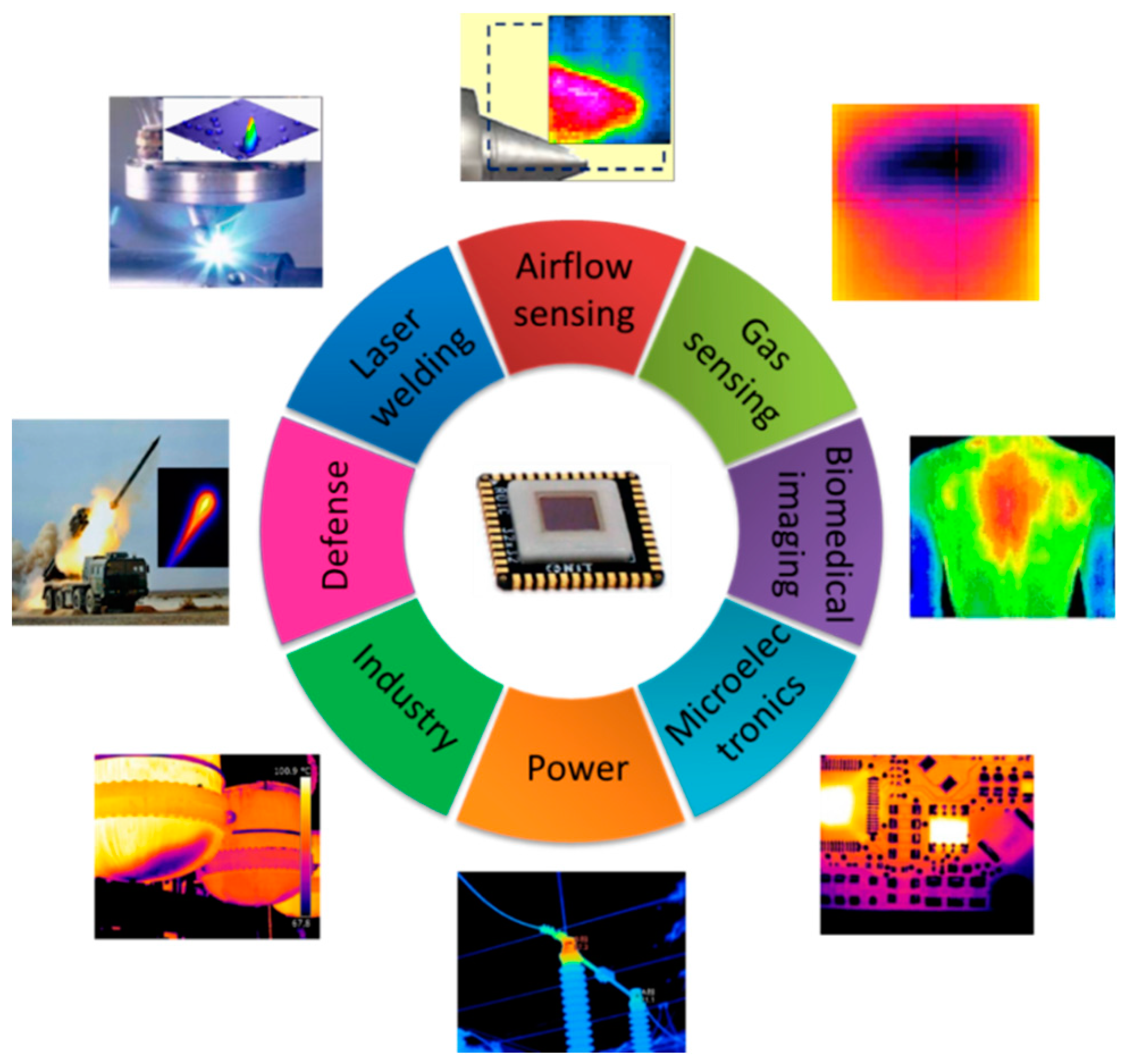
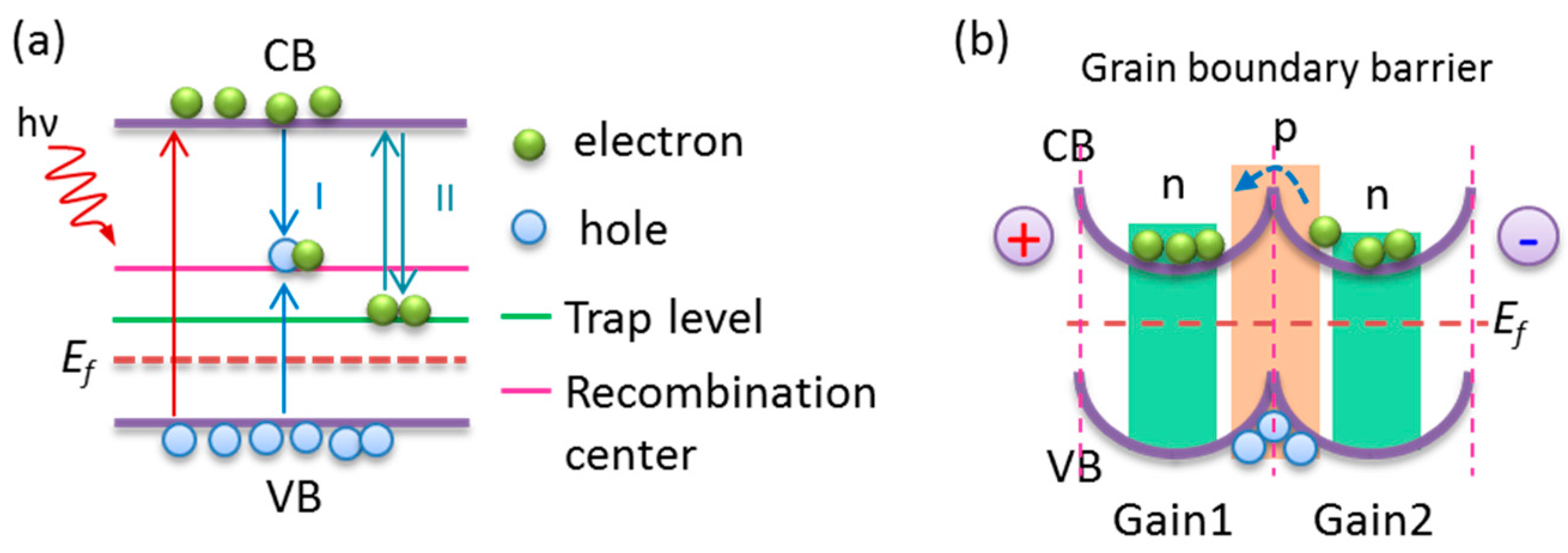
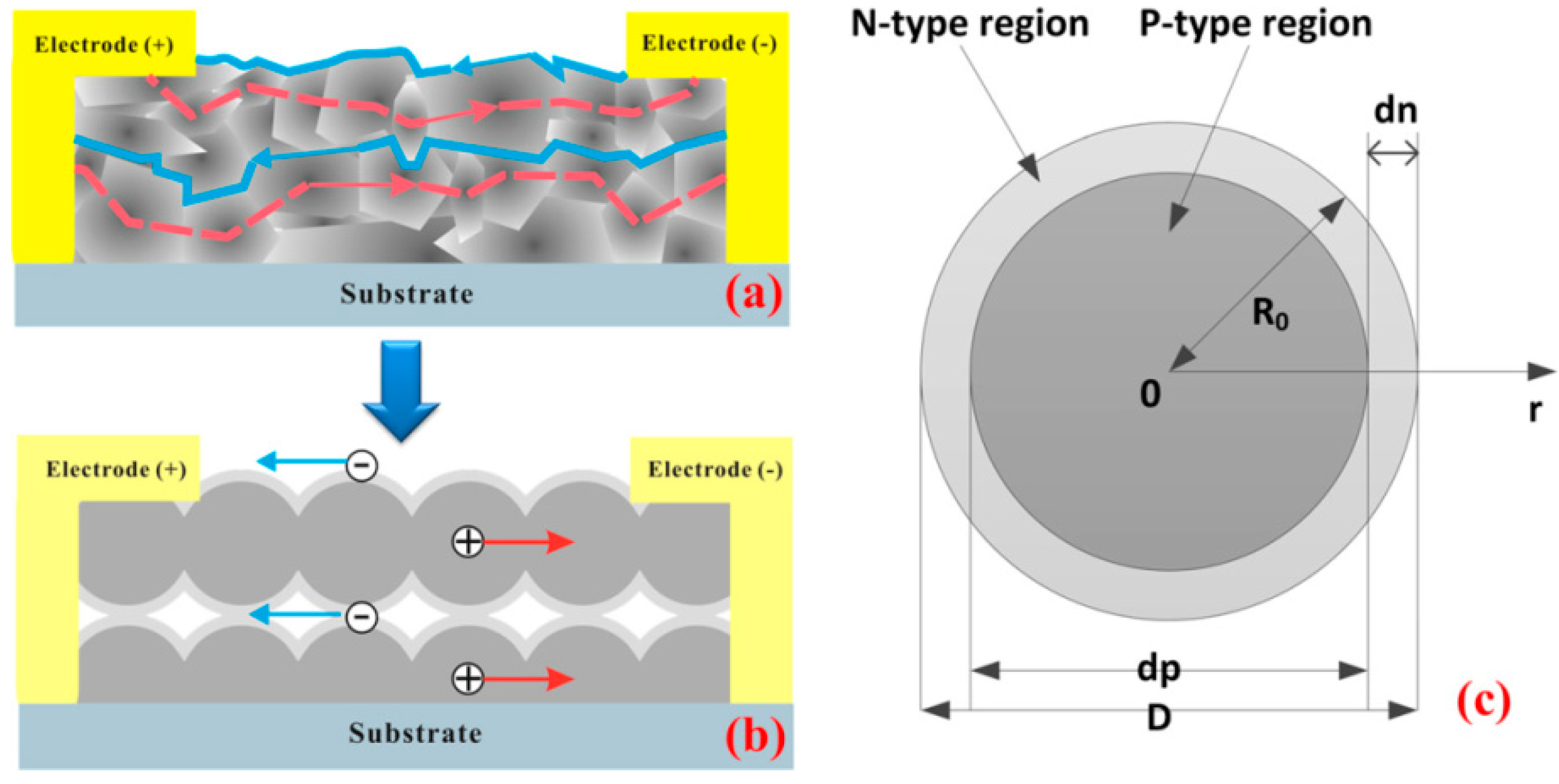
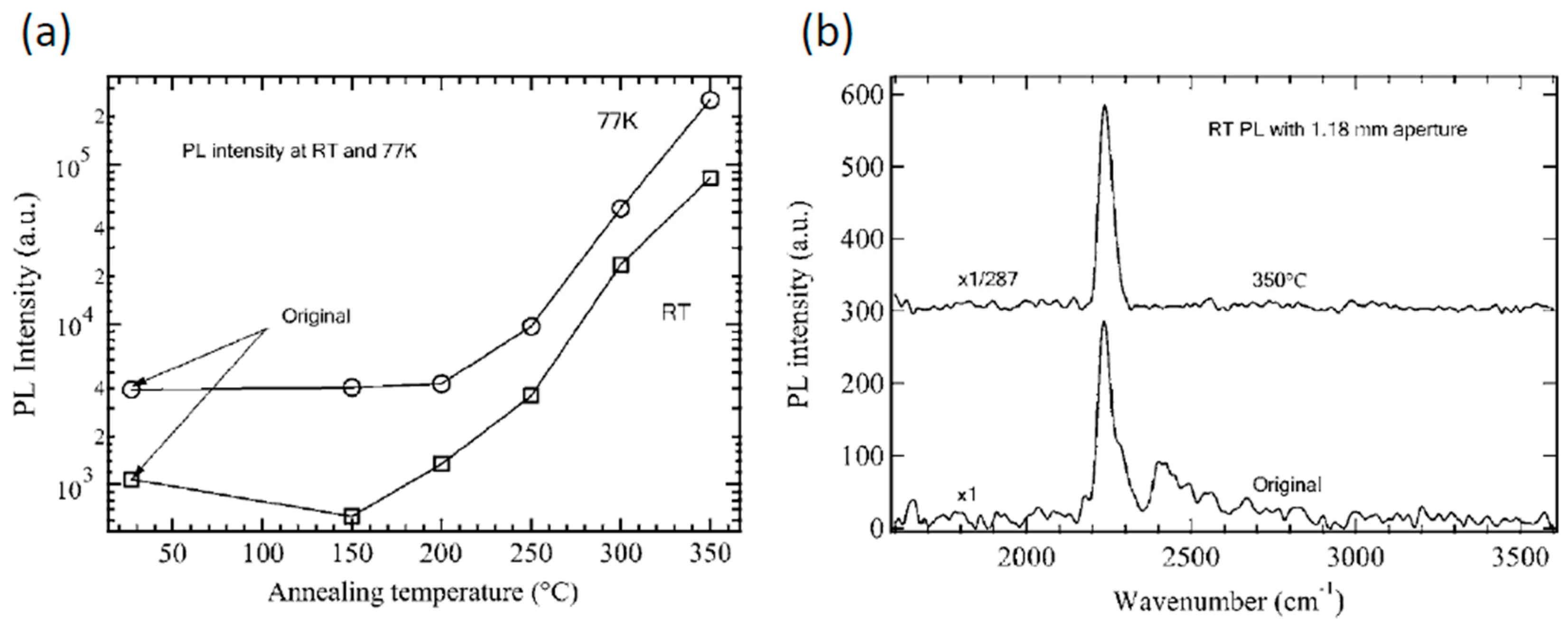

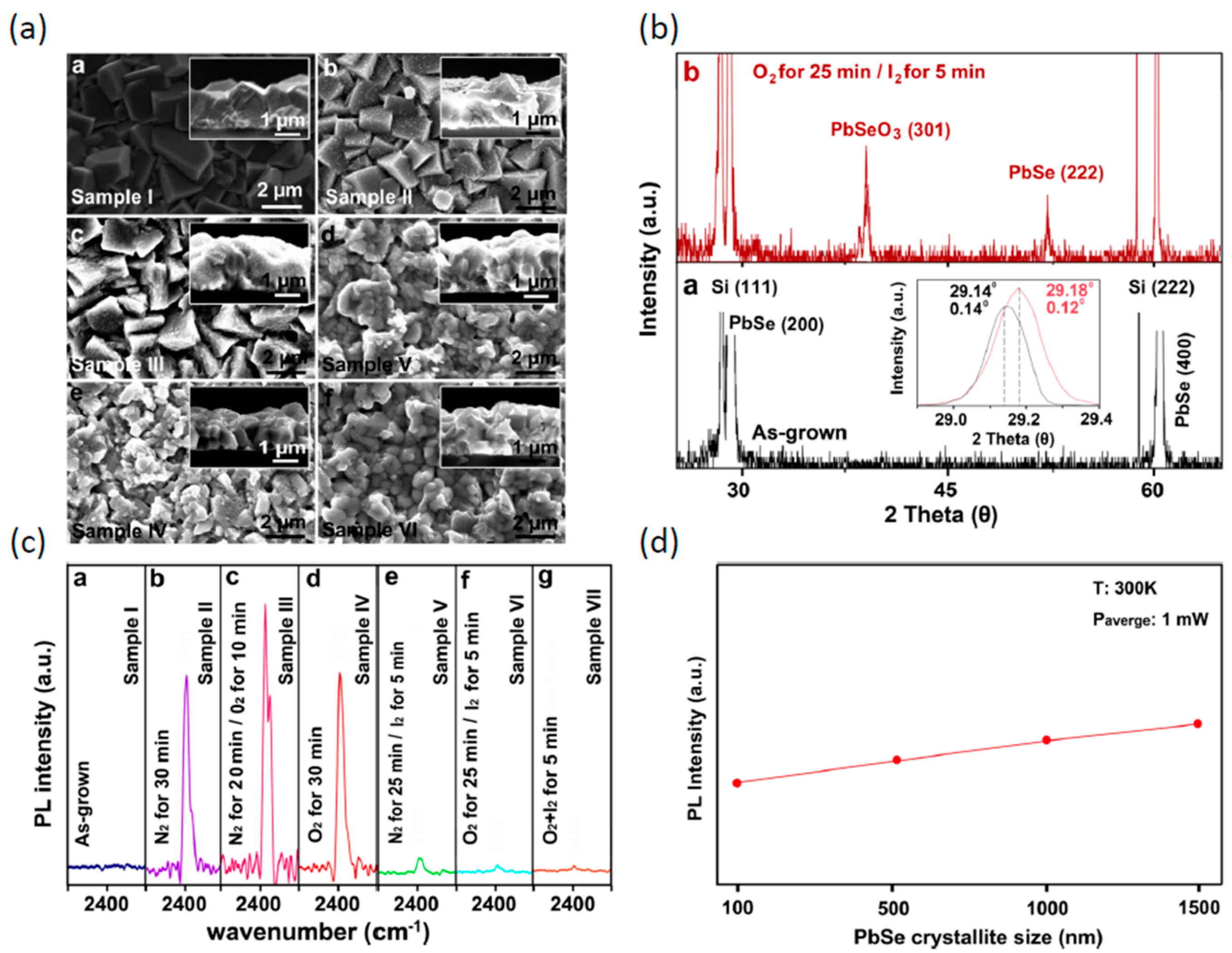
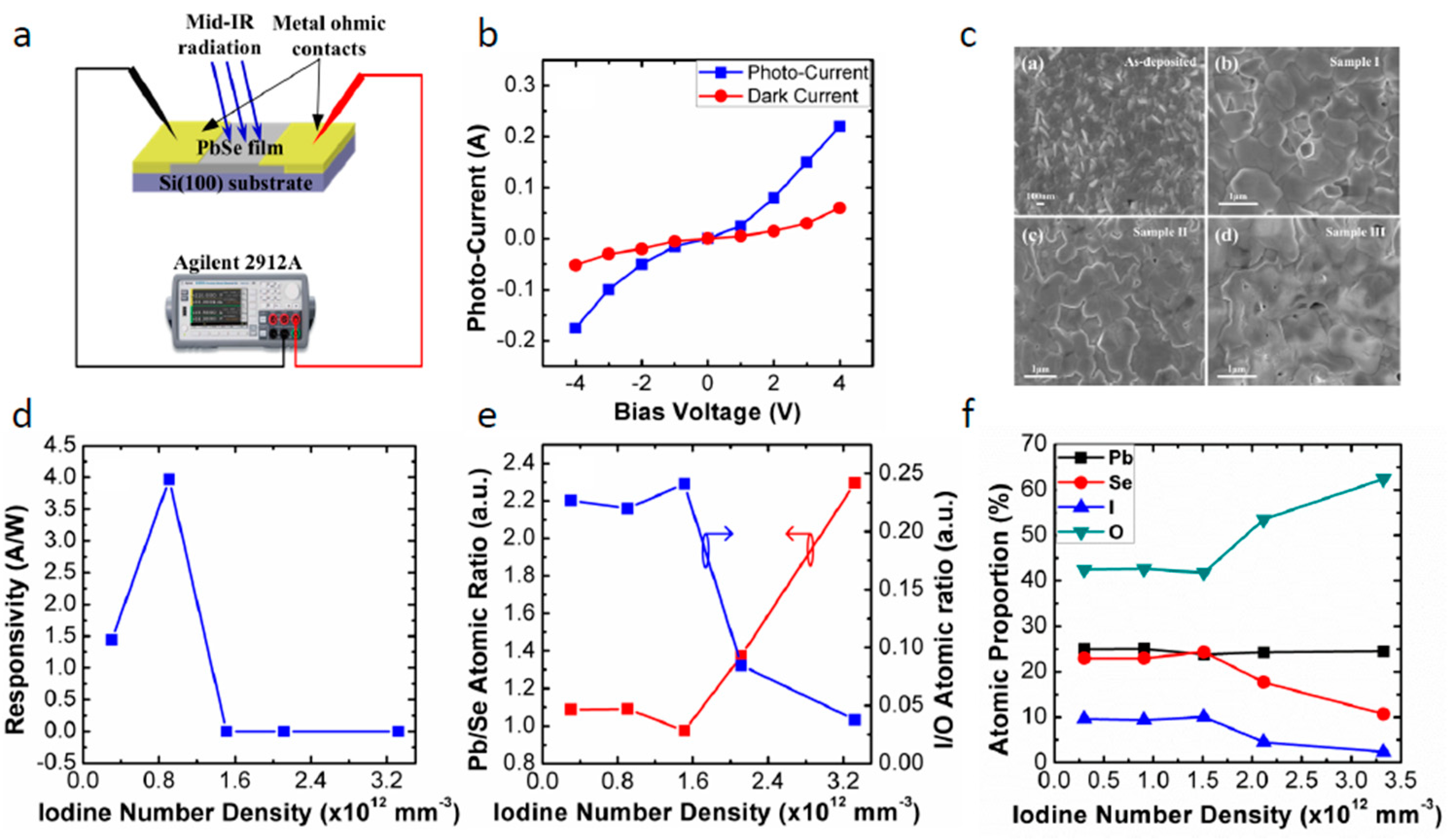
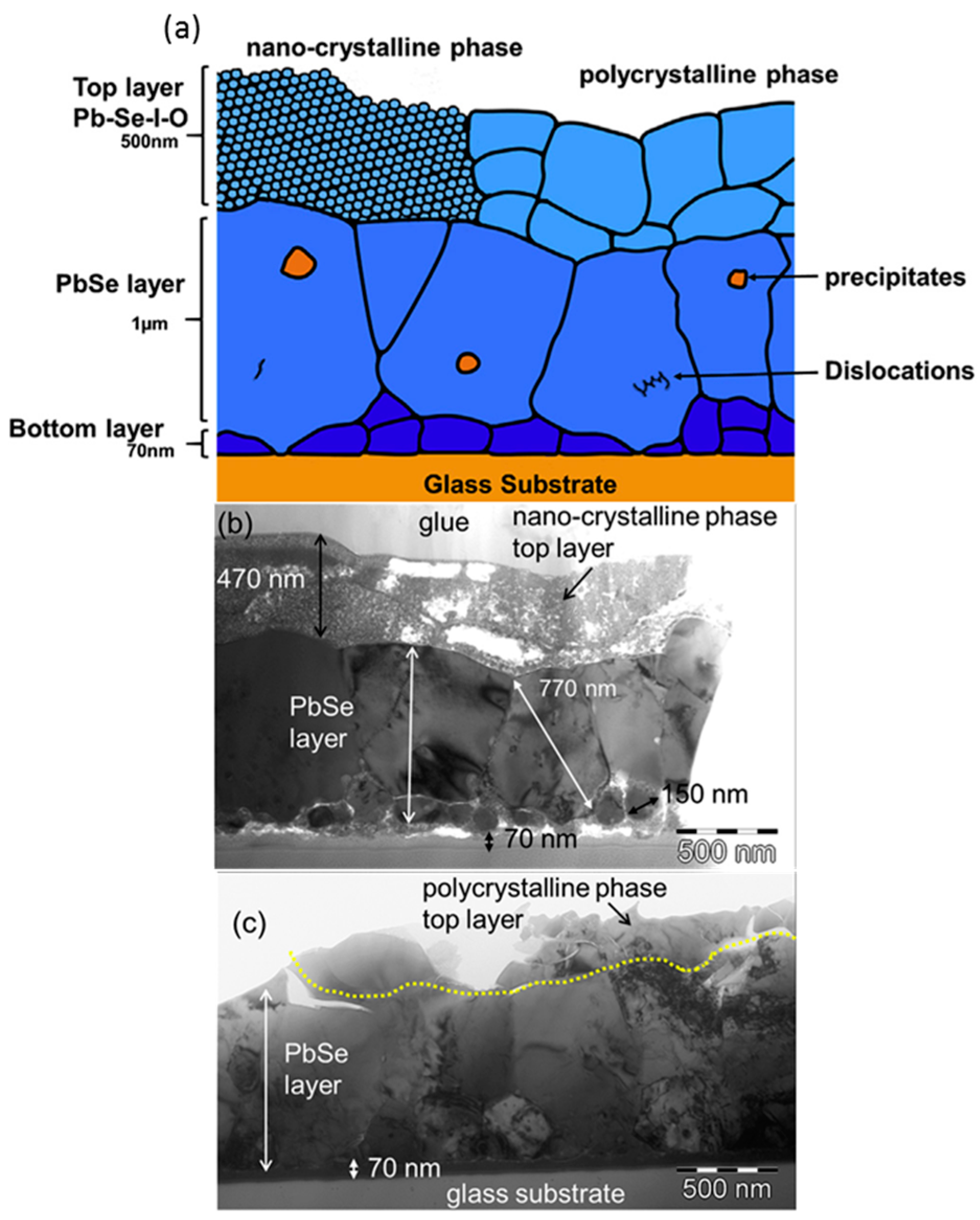
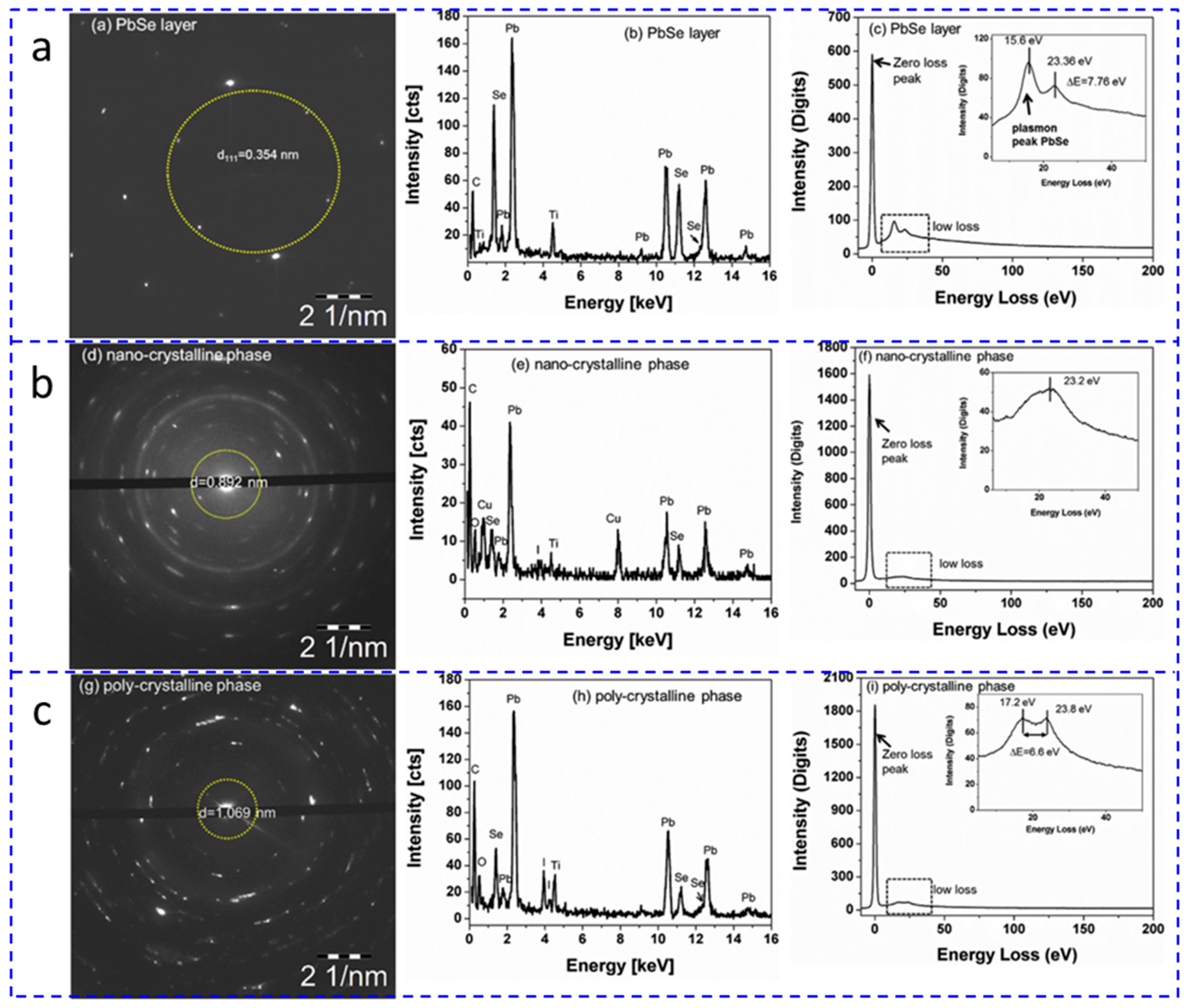
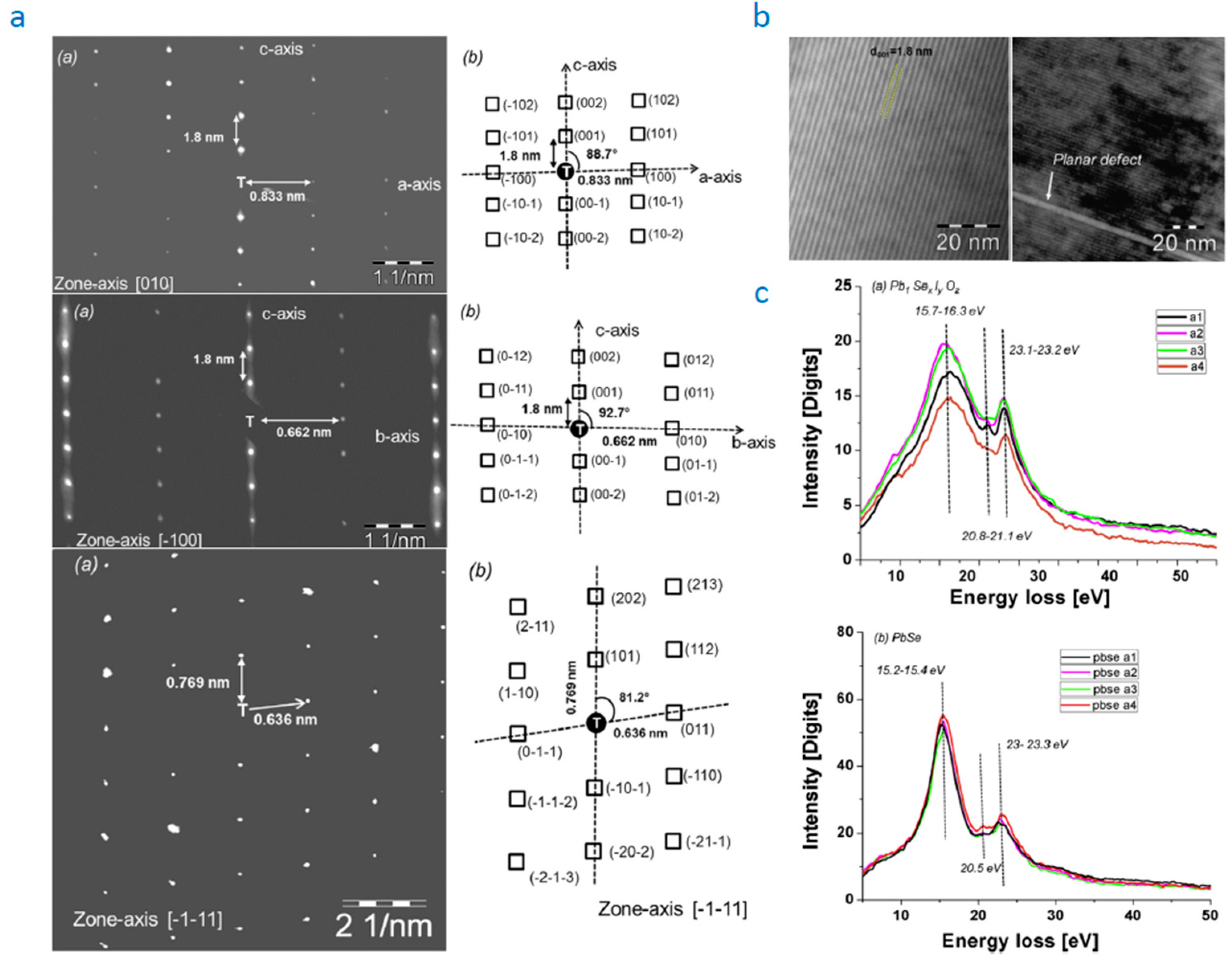
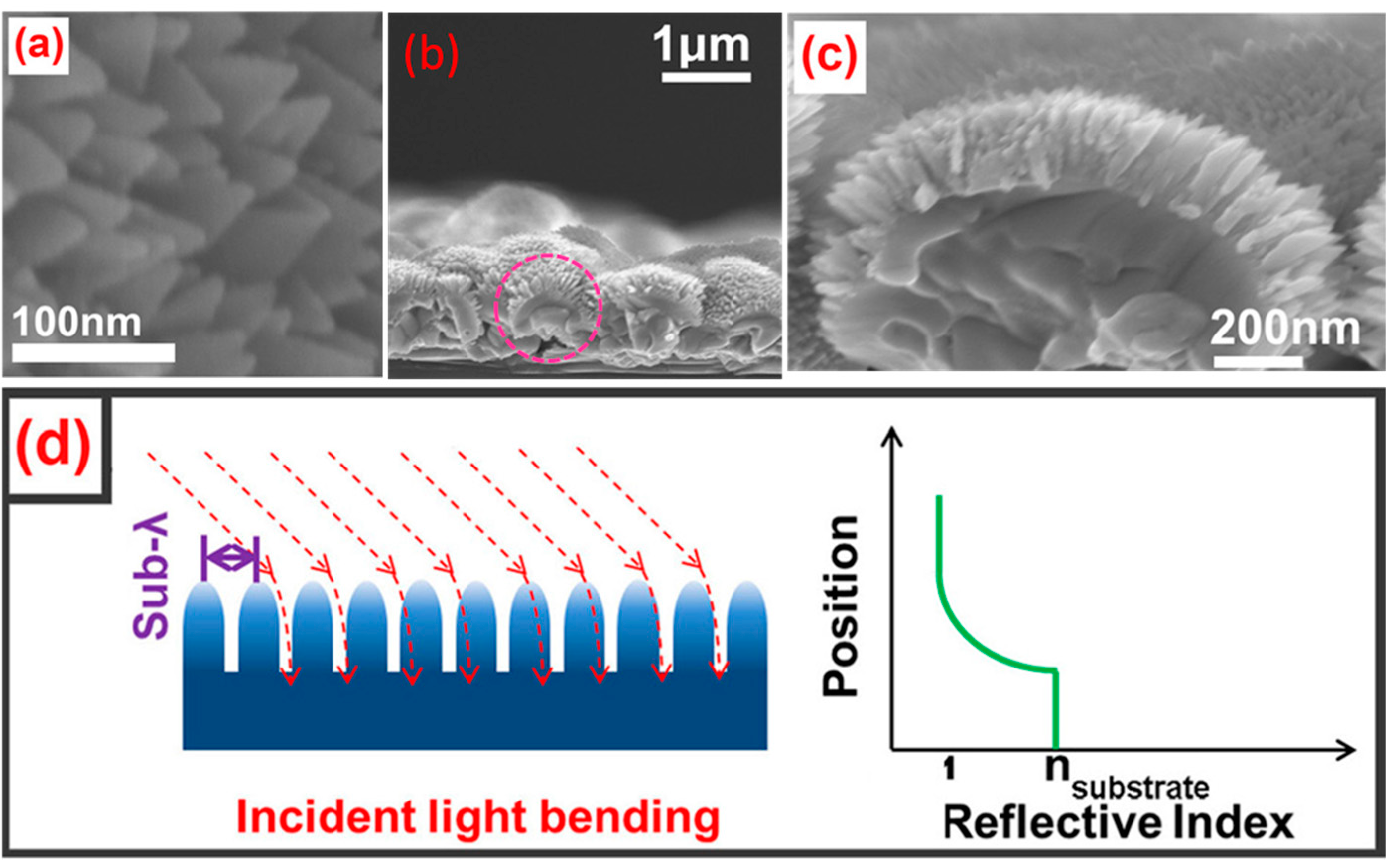

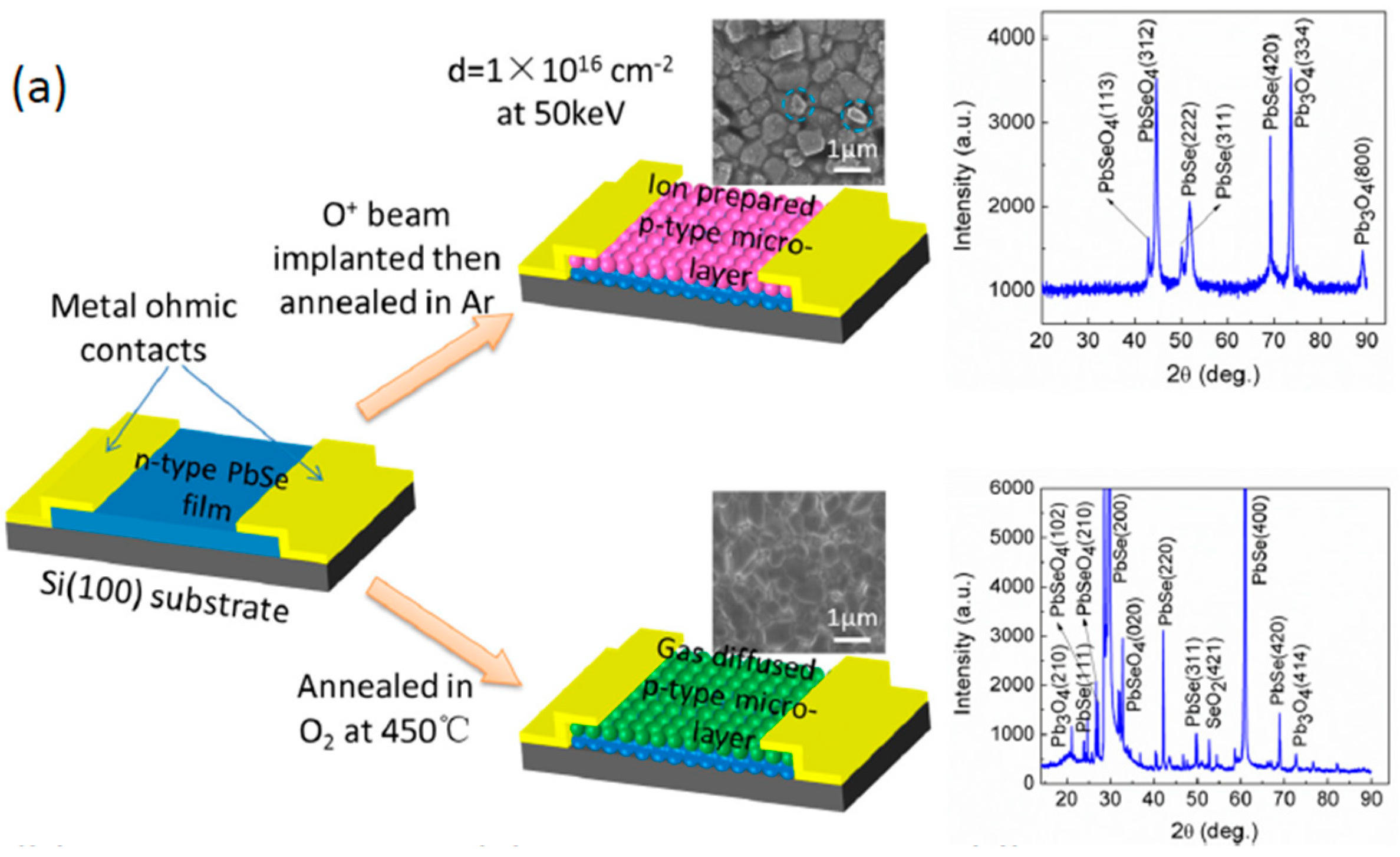
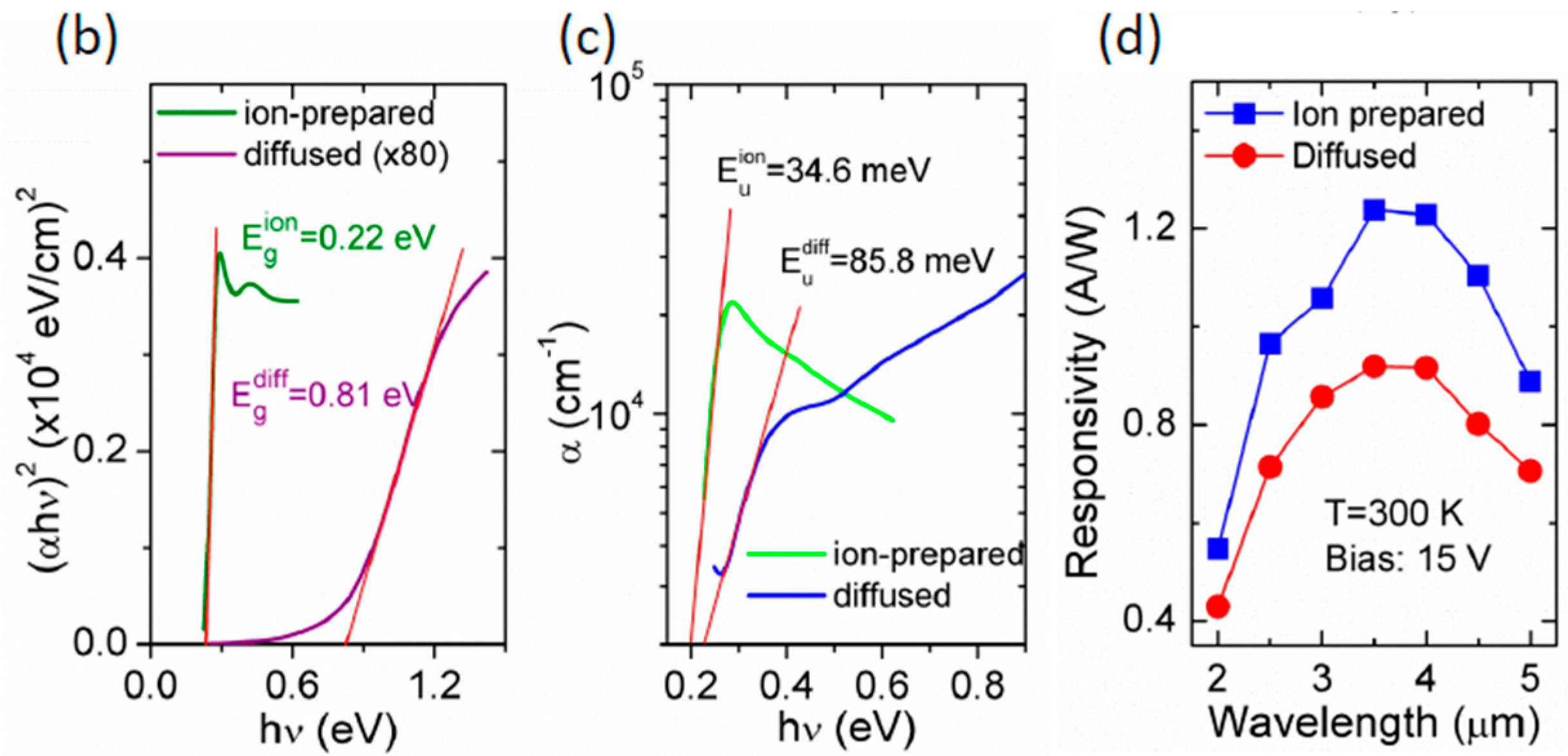
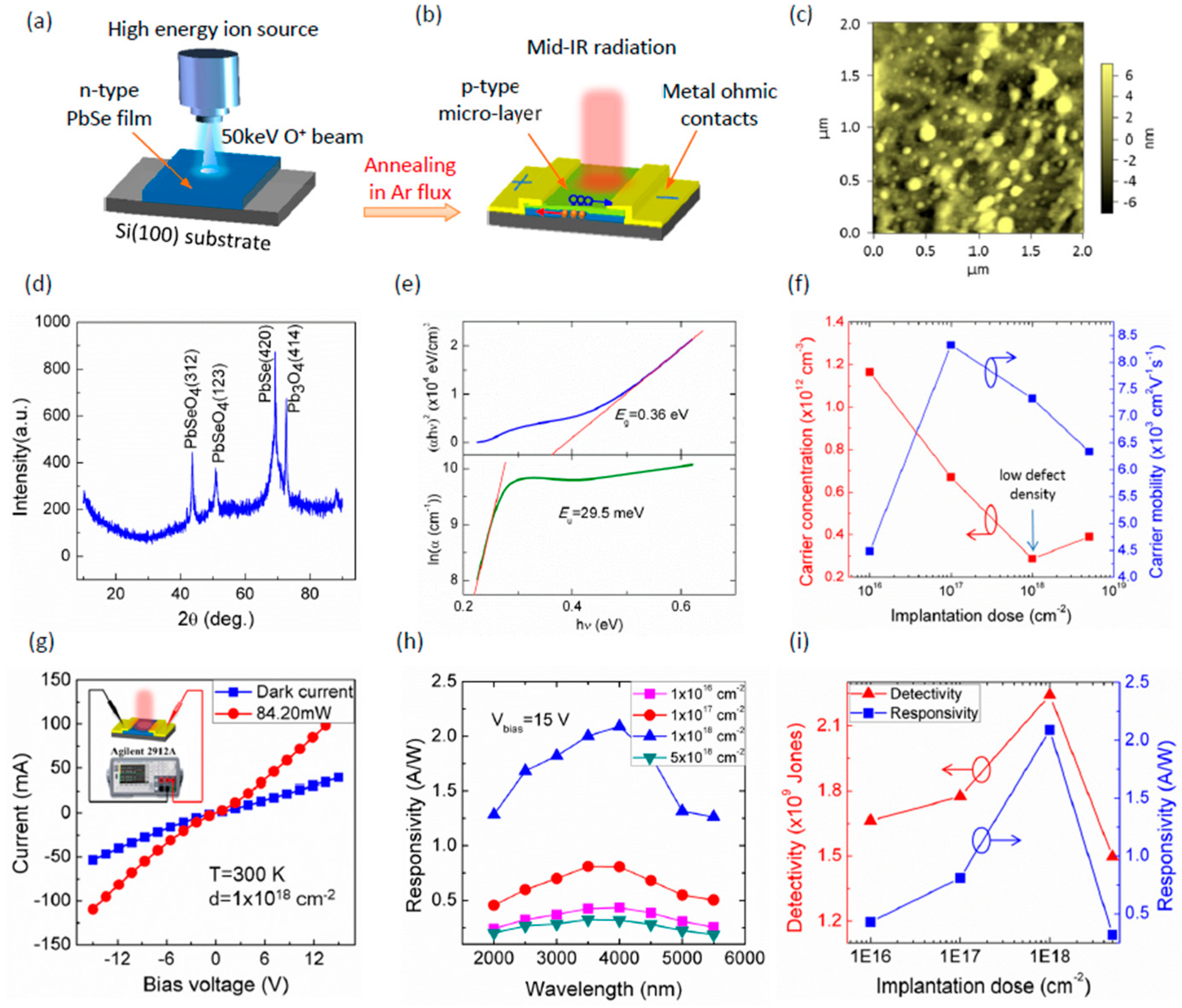
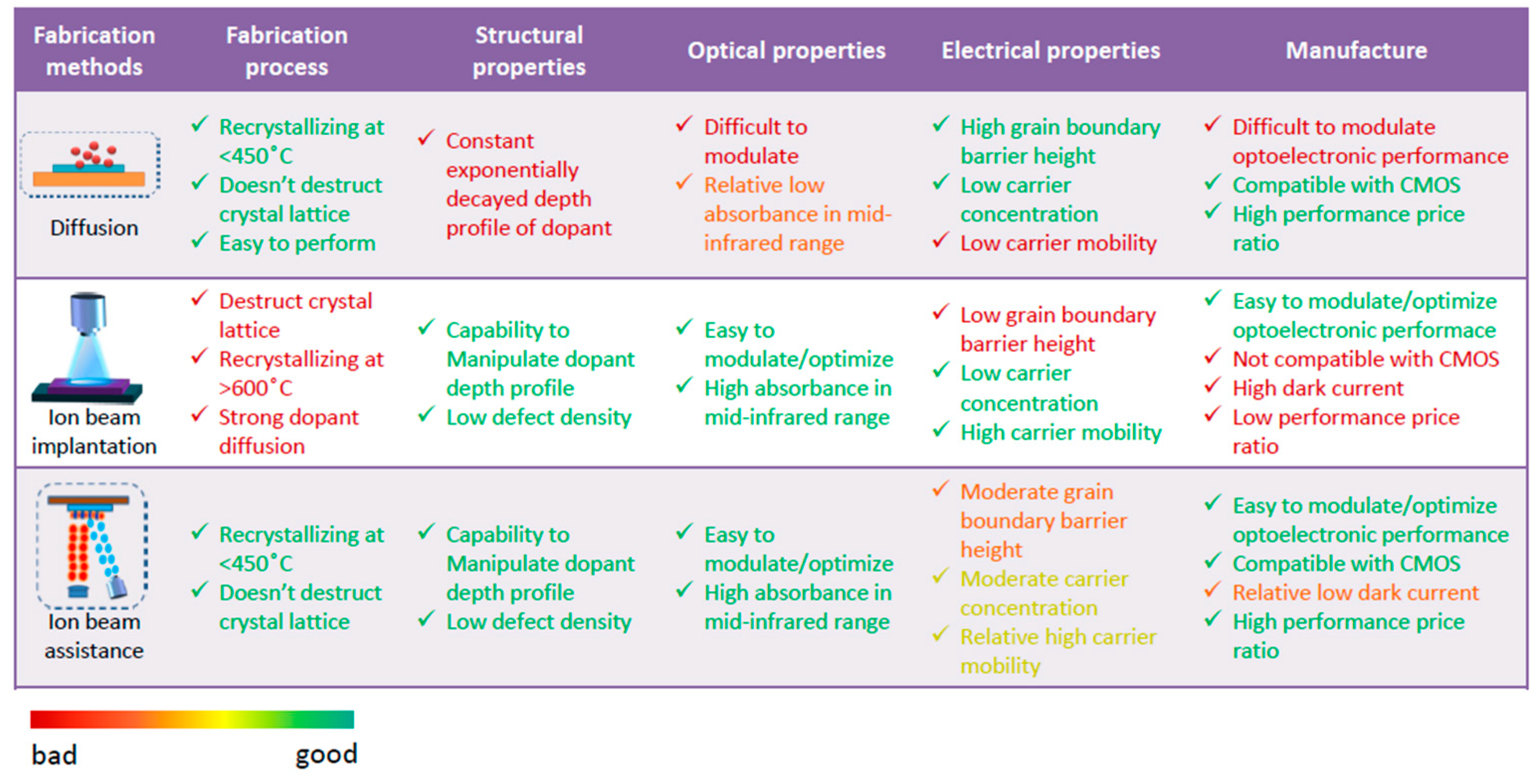
© 2018 by the authors. Licensee MDPI, Basel, Switzerland. This article is an open access article distributed under the terms and conditions of the Creative Commons Attribution (CC BY) license (http://creativecommons.org/licenses/by/4.0/).
Share and Cite
Yang, H.; Li, X.; Wang, G.; Zheng, J. Lead Selenide Polycrystalline Coatings Sensitized Using Diffusion and Ion Beam Methods for Uncooled Mid-Infrared Photodetection. Coatings 2018, 8, 444. https://doi.org/10.3390/coatings8120444
Yang H, Li X, Wang G, Zheng J. Lead Selenide Polycrystalline Coatings Sensitized Using Diffusion and Ion Beam Methods for Uncooled Mid-Infrared Photodetection. Coatings. 2018; 8(12):444. https://doi.org/10.3390/coatings8120444
Chicago/Turabian StyleYang, Hao, Xiaojiang Li, Guodong Wang, and Jianbang Zheng. 2018. "Lead Selenide Polycrystalline Coatings Sensitized Using Diffusion and Ion Beam Methods for Uncooled Mid-Infrared Photodetection" Coatings 8, no. 12: 444. https://doi.org/10.3390/coatings8120444
APA StyleYang, H., Li, X., Wang, G., & Zheng, J. (2018). Lead Selenide Polycrystalline Coatings Sensitized Using Diffusion and Ion Beam Methods for Uncooled Mid-Infrared Photodetection. Coatings, 8(12), 444. https://doi.org/10.3390/coatings8120444




